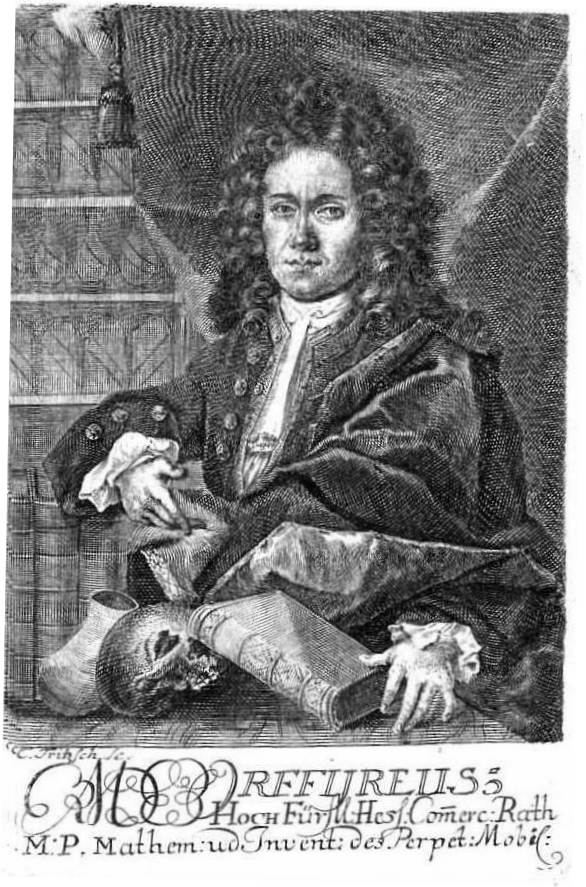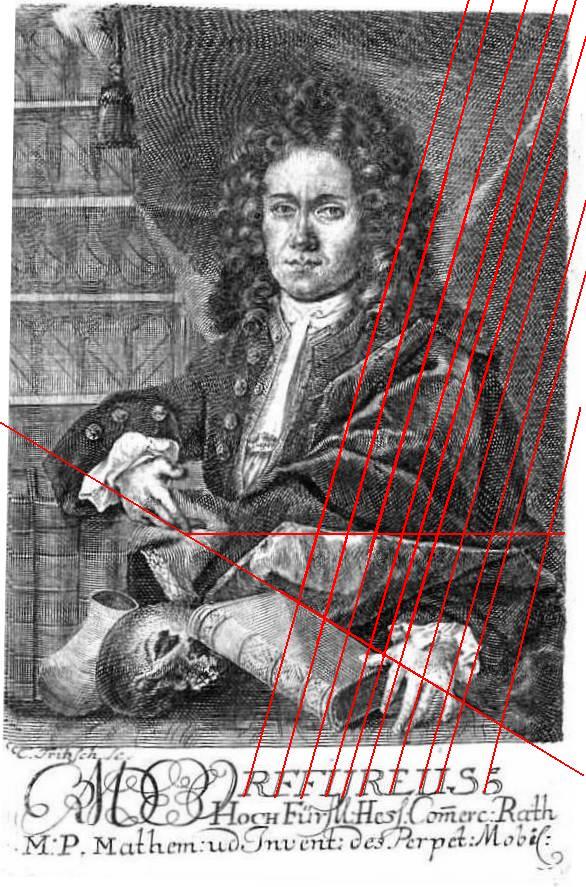|
There are a number of anomalies connected with the portraits of Bessler in ‘Das Triumphirende’ and the objects included in them are of interest. In the picture below notice the presence of a jar, skull and book. These are generally inluded in art as representative of a concept described as ‘Memento Mori’ a reminder that we all must die one day. The same objects may also be included as symbols of a similar theme known in Latin as ‘Vanitas’, meaning "emptiness" and is interpreted as indicating the insignificance of our earthly existence and the temporary quality of vanity. Other symbols indicative of death include hour glasses, clocks, extinguished or guttering candles, fruit,flowers, musical instruments, wine, bones, coffins, urns, angel of death, upside-down torches, graves and ravens, cypresses, weeping willows, tuberoses and parsley!
The text under the portrait holds more mysteries. The first thing to notice is the three upper case letter ‘M’s in the third line of text under the portrait. The first two are written in Roman font and could be taken as Roman numerals. The third ‘M’ is handwritten so is isolated from the first two by style.
It will be noticed that the two Roman ‘M’s, on either side of the capital ‘P’, contain the letter ‘V’ inside the two uprights, and the ‘V’s are accentuated and are blacker. This appears to be another reference to the number 5 and 5, the two 5s being so prevalent in Bessler’s writings. The letter ‘P’ between the two ‘M’s provides a fifth Roman upright with the other two from each letter ‘M’ and totals 5 again. After the ‘M.P.Mathem:’ he writes ‘ud’; strange spelling mistake as it should read ‘und’. He has omitted the letter ‘n’ which he often uses to represent the two ‘letter ‘v’s one upright the other upside down as in the capital ‘N’ - another pointer to 55? More clues lie buried within the text beneath the portrait. Take the second line for instance. The first word, ‘HOCH’, is in upper case but the first letter is extra large. The next two words ‘Fur’ and ‘Hes’ also begin with a similar sized capital but the remainder of each word is lower case. The remaining two words, ‘Comerc:Rath’, begin with capitals but they are not styled as Roman numbers, as is the case with the first two words, but are as handwritten examples. The only reason I can come up with is that the five uprights so identified represent the number five again! But why did he not put the rest of the word ‘HOCH’ in lower case, as he did with the subsequent two words? Bessler has included a number of abbreviations in the above text and has indicated that he has done so by adding a colon to the end of each abbreviated word. So ‘Hess:, Comerc:, Mathem:, Invent:, Perpet:, Mobil:’ have all been shortened - why? The omission of the letter ‘n’ in ‘und’ seems to highlight the abbreviations. The only reason I can think of for reducing the number of letters is because Bessler wanted to have a certain number of them. The number of letters in the last line is 30. The number of letters in the second line is 20, if you ignore the less precisely drawn letters which are between ‘fur’ and ‘Hes’ and ‘Hes’ and ‘Comerc’. So that totals 50, but there are also five capital letters starting words in the sentence - H F H C and R. Is this a symbol of 5 again? I don’t know but I include it as a possibility, however a vague one. I have some doubt as to whether I have made the right interpretation of the above features but I am certain that the abbreviations are deliberate and not just to save space. He could easily have added a fourth line if he wished to. The top line of text which also holds the baseline of the pentagram in the portrait also has some other aspects which appear to hold some kind of information. I have been uinable to make perfect sense of the decorative scribble before the name Orffyreus, but it seems to me that it contains firstly the letter ‘J’, once the right way round and then reversed’ the same technique has been applied the following letter ‘E’. Perhaps it indicates the fact that his wheel was capable of turning in either direction. And finally, returning to the pentagram I described earlier in Bessler's portrait, notice in the drawing below, I have drawn the same upright from the incomplete ‘five’ at the end of the word ORFFYREUS, as I showed there, and drawn the horizontal from where the upright crosses the edge of the picture straight across to Bessler’s pointing finger, and thirdly, drawn in the line which aligns with the edge of the book and meets the horizontal at the same finger tip. Then I added more uprights from all of the upright sloping lines drawn to comprise the name ORFFYREUS. There are ten in all, if you include the missing upright from the incomplete five - in total, two fives. If you think that’s stretching things too far bear in mind that the letter ‘Y’ has been drawn rather incongruously with two uprights. Note that the only letter which doesn’t have an upright is the letter ‘S’ strangely formed to look like another ‘5’!
I have hesitated at length over whether to include this next piece as I remain sceptical of its validity, nevertheless it would be remiss of me not to include anything, however bizarre, just in case it turns out to have been relevant. The three objects in the portrait described earlier as symbols of memento mori, the jar, skull and book, also occur widely in the world of medieval art and are specifically included in paintings representing Mary Magdalene. My first reaction to this discovery was that this was coincidental and had nothing to do with Bessler. However there is a connection no matter that it is extremely obscure. Firstly I would point to the two capital ‘letter ‘M’s in the bottom line above. It was customary to include double ‘M’ designs in paintings which depicted her and that could be a second layer of meaning deliberately included by Bessler. But why the Magdalene? Given Bessler’s predilection for the number five and pentagrams I sought a connection between the Magdalene and the pentagram and of course found not one, but many. There is an excellent thesis etd.fcla.edu/SF/SFE0000365/Thesis-PDF.pdf on the subject of the depiction,in Renaissance art, of the Magdelene as the heavenly Venus. By Bessler’s time the two images were irrevocably intertwined and there is no doubt that the Venus was commonly associated with the Magdalene then. But how do we get from Venus to the pentagram? It seems that the pentagram has long been associated with the planet Venus and Dan Brown in his book ‘The Lost Symbol’ makes much of this as if it were a fact. There is an argument that asserts that the planet Venus during its change of position in our night sky, describes a pentgram and the best description I found was as follows:- “As Venus orbits the Sun, it would follow an elliptical orbit, but only from the point of view of the Sun. Because Earth also orbits the Sun, the two motions are combined, giving a different shape. So is all this in aid of just another pointer to the pentagram? Did Bessler know of the association of Mary Magdalene, Venus and the pentagram? Who knows? I don’t, but I offer it as another interpretation to be considered and/or rejected.
Copyright © 2011 John Collins.
|
| NavB[Home] [Bessler's name code] [Apologia Pentagram] [AP chronogram] [AP blanks & dashes] [AP Chapter 55] [Bessler's Initials] [Portrait pentagram] [More 1st portrait] [2nd portrait] [Pentagram in GB] [Golden Mean] [MT 55 pentagram] [MT Nos & letters] [MT 137 part one] [MT 137 part two] [MT 137 part three] [Bessler's Logo] [Drawing no codes] [5th DT Drawing] [Water wheel]wing |


